Abstract
OBJECTIVE--To compare the ability of tests measuring two hour plasma glucose, fasting plasma glucose, and glycated haemoglobin concentrations in predicting the specific microvascular complications of non-insulin dependent diabetes mellitus. DESIGN--Cross sectional and longitudinal analysis of the relation between complications and concomitant results of the three tests. SETTING--Gila River Indian Community, Arizona. SUBJECTS--Pima Indians (cross sectional, n = 960), aged 25 years or above who were not receiving insulin or oral hypoglycaemic treatment at the baseline examination. MAIN OUTCOME MEASURES--Development of retinopathy and nephropathy. RESULTS--Cross sectionally, frequency distributions of logarithms of the three sets of results were bimodal, with the prevalence of retinopathy and nephropathy being, respectively, 12.0-26.7 and 3.9-4.2 times as high above as below cut off points which minimised overlap (two hour plasma glucose concentration 12.6 mmol/l; fasting plasma glucose concentration 9.3 mmol/l; glycated haemoglobin (HbA1c) concentration 7.8%). Longitudinally, each of the three measures of glycaemia significantly predicted the development of retinopathy (P < 0.0001) and nephropathy (P < 0.05). Receiver operating characteristic curves showed that two hour plasma glucose concentration was superior to fasting plasma glucose concentration (P < 0.05) for prevalent cases of retinopathy, but otherwise no variable had a significant advantage for detecting incident or prevalent cases of either complication. CONCLUSIONS--These findings suggest that determination of glycated haemoglobin or fasting plasma glucose concentrations alone may be acceptable alternatives to measuring glucose concentration two hours after challenge with 75 g glucose for the diagnosis of diabetes.
Full text
PDF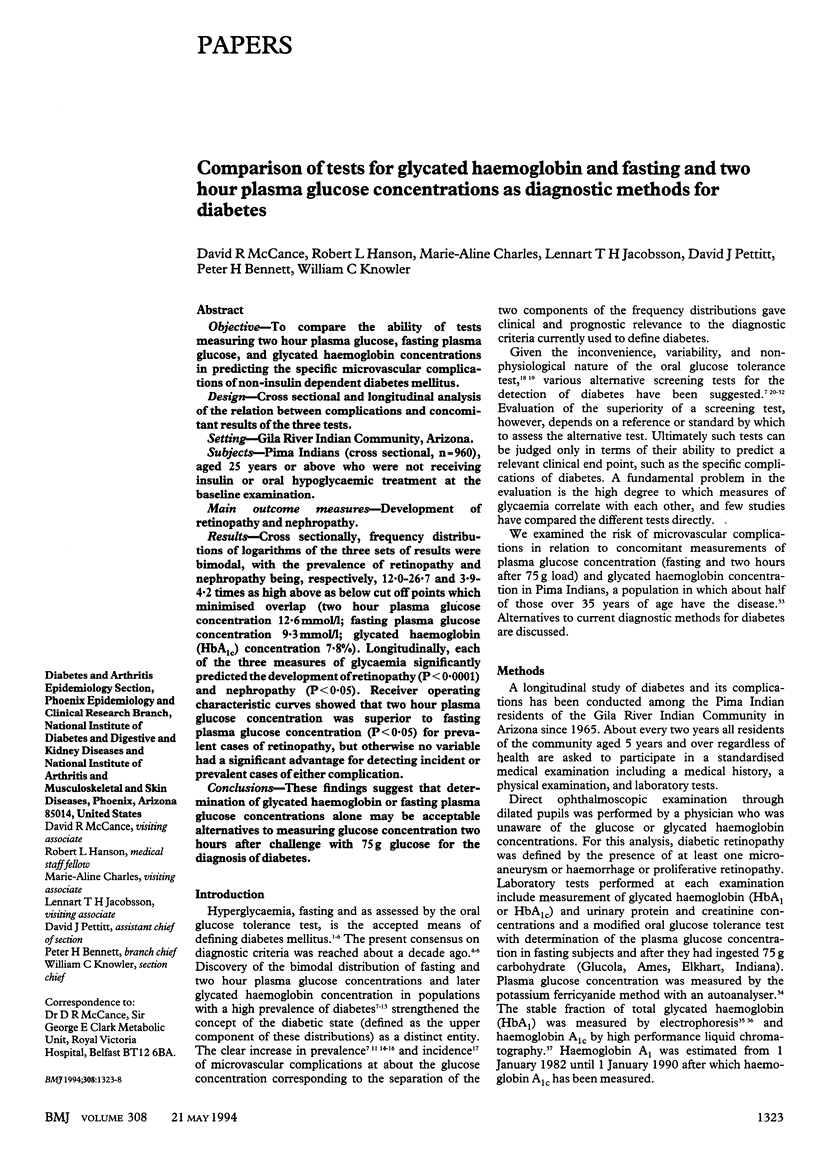
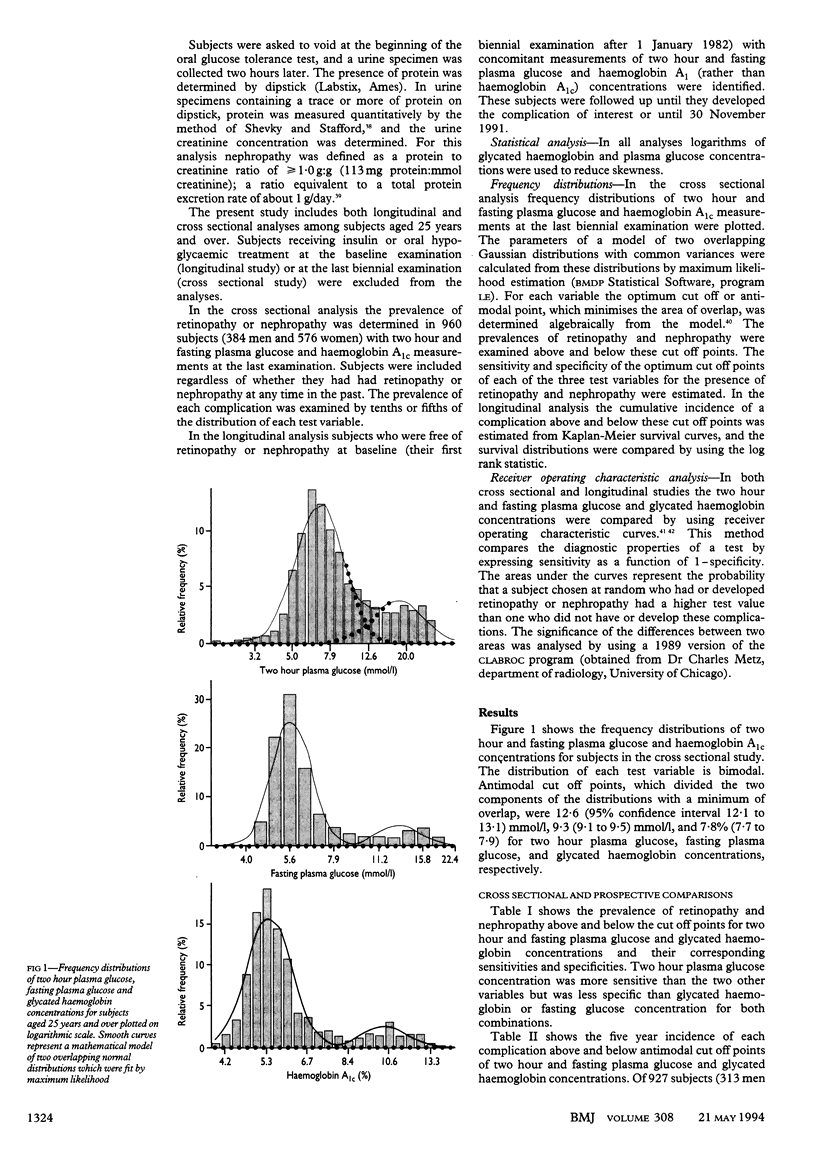
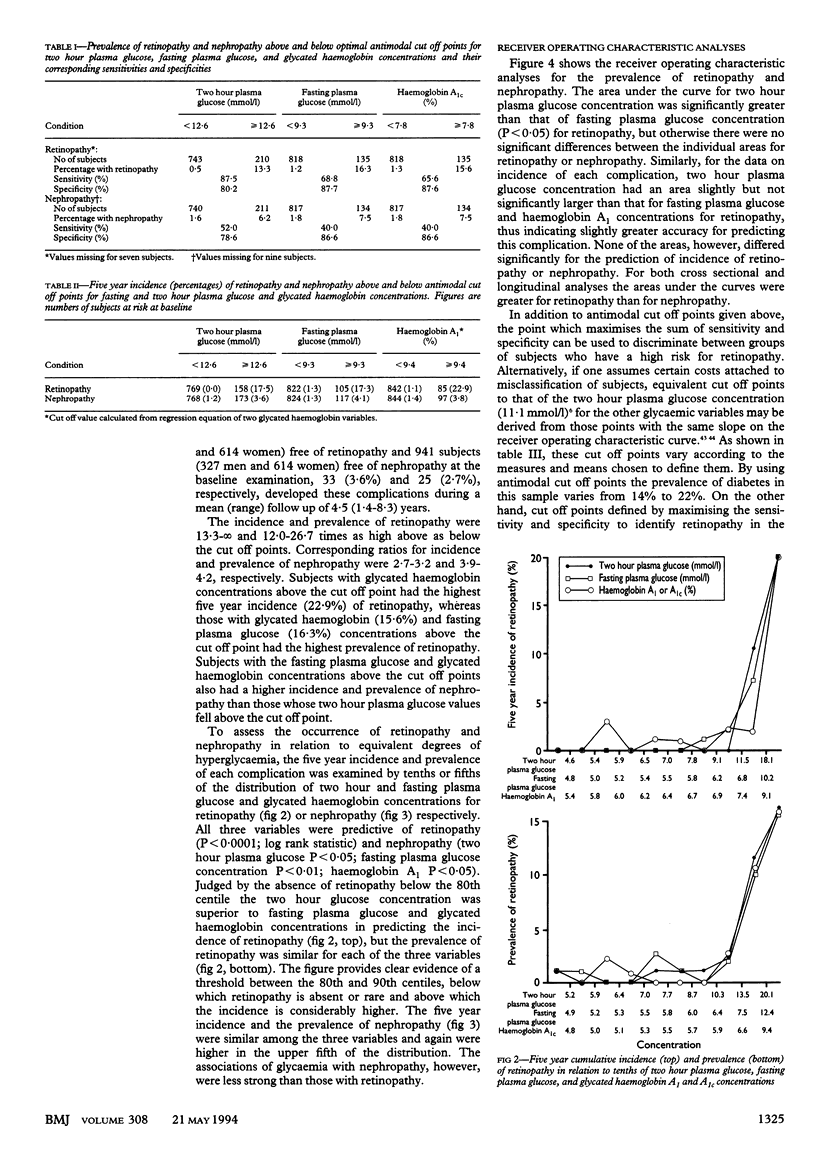
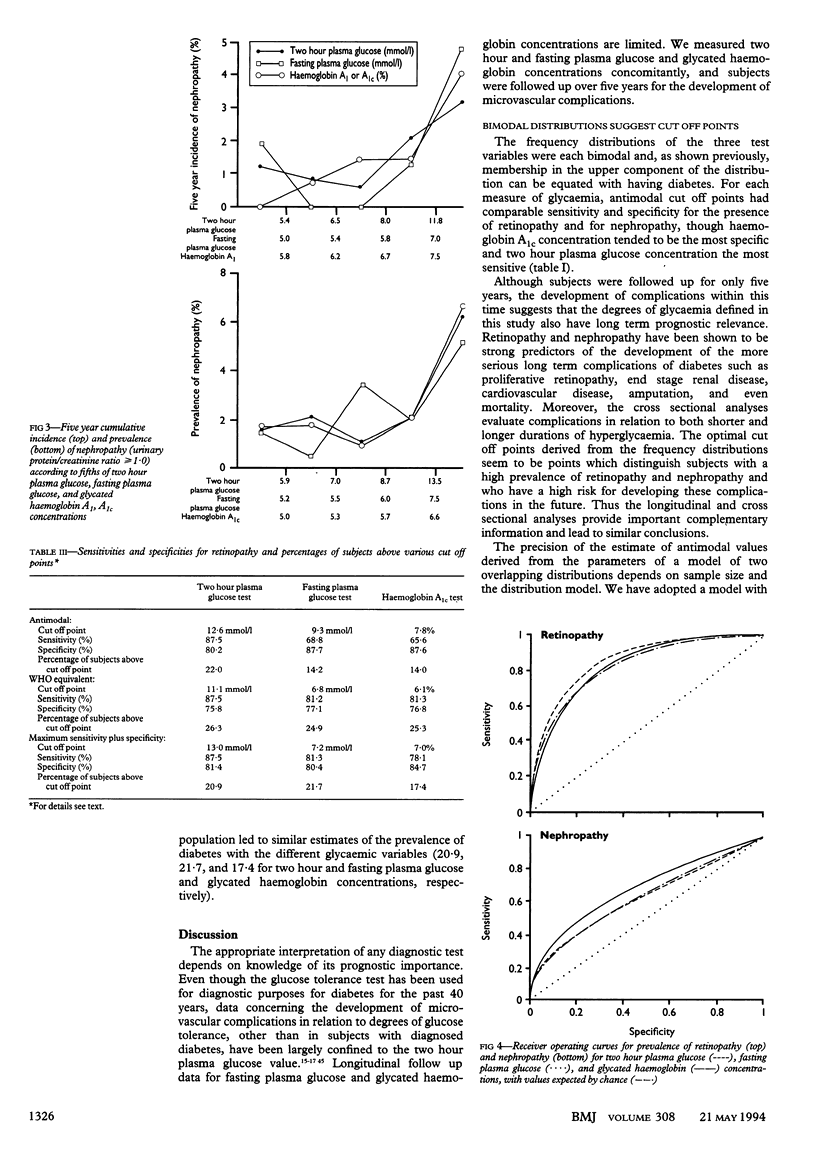
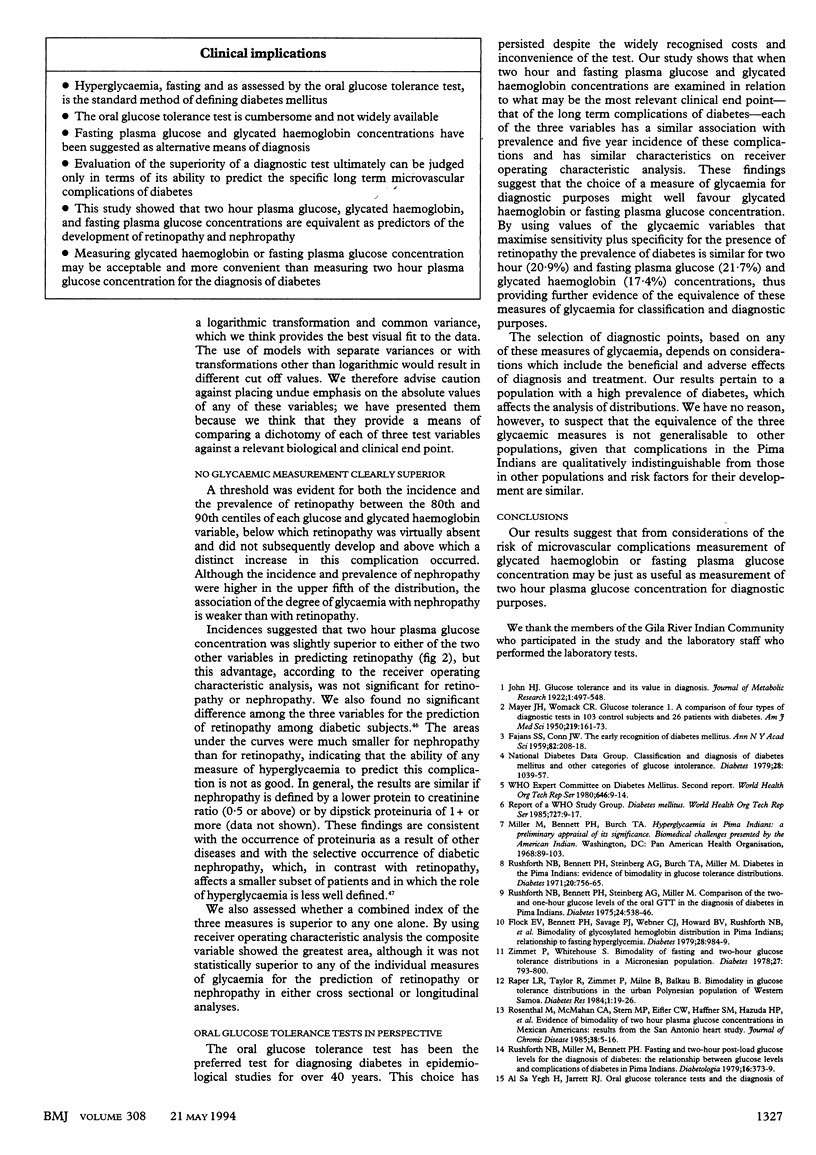
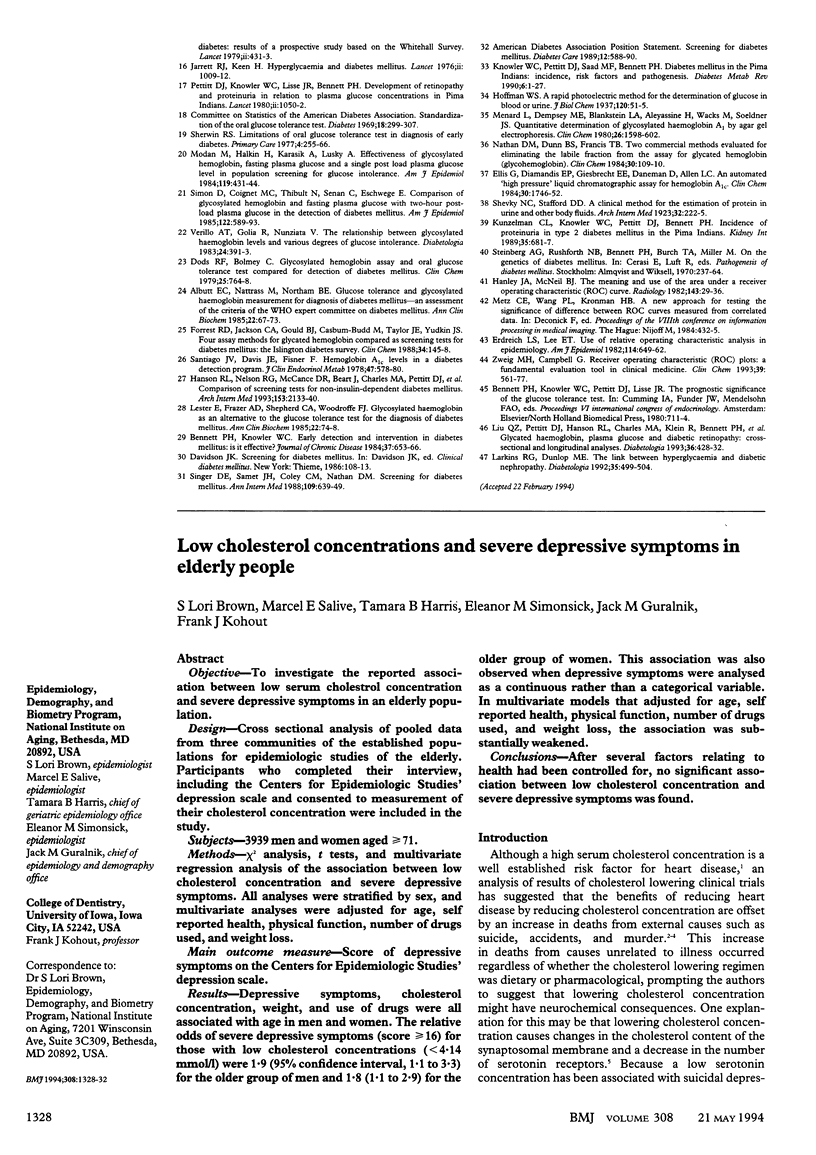
Selected References
These references are in PubMed. This may not be the complete list of references from this article.
- Albutt E. C., Nattrass M., Northam B. E. Glucose tolerance test and glycosylated haemoglobin measurement for diagnosis of diabetes mellitus--an assessment of the criteria of the WHO Expert Committee on Diabetes Mellitus 1980. Ann Clin Biochem. 1985 Jan;22(Pt 1):67–73. doi: 10.1177/000456328502200106. [DOI] [PubMed] [Google Scholar]
- Bennett P. H., Knowler W. C. Early detection and intervention in diabetes mellitus: is it effective? J Chronic Dis. 1984;37(8):653–666. doi: 10.1016/0021-9681(84)90116-4. [DOI] [PubMed] [Google Scholar]
- Dods R. F., Bolmey C. Glycosylated hemoglobin assay and oral glucose tolerance test compared for detection of diabetes mellitus. Clin Chem. 1979 May;25(5):764–768. [PubMed] [Google Scholar]
- Ellis G., Diamandis E. P., Giesbrecht E. E., Daneman D., Allen L. C. An automated "high-pressure" liquid-chromatographic assay for hemoglobin A1c. Clin Chem. 1984 Nov;30(11):1746–1752. [PubMed] [Google Scholar]
- FAJANS S. S., CONN J. W. The early recognition of diabetes mellitus. Ann N Y Acad Sci. 1959 Sep 25;82:208–218. doi: 10.1111/j.1749-6632.1959.tb44901.x. [DOI] [PubMed] [Google Scholar]
- Flock E. V., Bennett P. H., Savage P. J., Webner C. J., Howard B. V., Rushforth N. B., Miller M. Bimodality of glycosylated hemoglobin distribution in Pima Indians: relationship to fasting hyperglycemia. Diabetes. 1979 Nov;28(11):984–989. doi: 10.2337/diab.28.11.984. [DOI] [PubMed] [Google Scholar]
- Forrest R. D., Jackson C. A., Gould B. J., Casburn-Budd M., Taylor J. E., Yudkin J. S. Four assay methods for glycated hemoglobin compared as screening tests for diabetes mellitus: the Islington Diabetes Survey. Clin Chem. 1988 Jan;34(1):145–148. [PubMed] [Google Scholar]
- Hanley J. A., McNeil B. J. The meaning and use of the area under a receiver operating characteristic (ROC) curve. Radiology. 1982 Apr;143(1):29–36. doi: 10.1148/radiology.143.1.7063747. [DOI] [PubMed] [Google Scholar]
- Hanson R. L., Nelson R. G., McCance D. R., Beart J. A., Charles M. A., Pettitt D. J., Knowler W. C. Comparison of screening tests for non-insulin-dependent diabetes mellitus. Arch Intern Med. 1993 Sep 27;153(18):2133–2140. [PubMed] [Google Scholar]
- Jarrett R. J., Keen H. Hyperglycaemia and diabetes mellitus. Lancet. 1976 Nov 6;2(7993):1009–1012. doi: 10.1016/s0140-6736(76)90844-8. [DOI] [PubMed] [Google Scholar]
- Knowler W. C., Pettitt D. J., Saad M. F., Bennett P. H. Diabetes mellitus in the Pima Indians: incidence, risk factors and pathogenesis. Diabetes Metab Rev. 1990 Feb;6(1):1–27. doi: 10.1002/dmr.5610060101. [DOI] [PubMed] [Google Scholar]
- Kunzelman C. L., Knowler W. C., Pettitt D. J., Bennett P. H. Incidence of proteinuria in type 2 diabetes mellitus in the Pima Indians. Kidney Int. 1989 Feb;35(2):681–687. doi: 10.1038/ki.1989.39. [DOI] [PubMed] [Google Scholar]
- Larkins R. G., Dunlop M. E. The link between hyperglycaemia and diabetic nephropathy. Diabetologia. 1992 Jun;35(6):499–504. doi: 10.1007/BF00400475. [DOI] [PubMed] [Google Scholar]
- Lester E., Frazer A. D., Shepherd C. A., Woodroffe F. J. Glycosylated haemoglobin as an alternative to the glucose tolerance test for the diagnosis of diabetes mellitus. Ann Clin Biochem. 1985 Jan;22(Pt 1):74–78. doi: 10.1177/000456328502200107. [DOI] [PubMed] [Google Scholar]
- Liu Q. Z., Pettitt D. J., Hanson R. L., Charles M. A., Klein R., Bennett P. H., Knowler W. C. Glycated haemoglobin, plasma glucose and diabetic retinopathy: cross-sectional and prospective analyses. Diabetologia. 1993 May;36(5):428–432. doi: 10.1007/BF00402279. [DOI] [PubMed] [Google Scholar]
- MEYER J. H., WOMACK C. R. Glucose tolerance; a comparison of four types of diagnostic tests in 103 control subjects and 26 patients with diabetes. Am J Med Sci. 1950 Feb;219(2):161–173. doi: 10.1097/00000441-195002000-00007. [DOI] [PubMed] [Google Scholar]
- Menard L., Dempsey M. E., Blankstein L. A., Aleyassine H., Wacks M., Soeldner J. S. Quantitiative determination of glycosylated hemoglobin A1 by agar gel electrophoresis. Clin Chem. 1980 Oct;26(11):1598–1602. [PubMed] [Google Scholar]
- Modan M., Halkin H., Karasik A., Lusky A. Effectiveness of glycosylated hemoglobin, fasting plasma glucose, and a single post load plasma glucose level in population screening for glucose intolerance. Am J Epidemiol. 1984 Mar;119(3):431–444. doi: 10.1093/oxfordjournals.aje.a113761. [DOI] [PubMed] [Google Scholar]
- Nathan D. M., Dunn B. S., Francis T. B. Two commercial methods evaluated for eliminating the labile fraction from the assay for glycated hemoglobin (glycohemoglobin). Clin Chem. 1984 Jan;30(1):109–110. [PubMed] [Google Scholar]
- Pettitt D. J., Knowler W. C., Lisse J. R., Bennett P. H. Development of retinopathy and proteinuria in relation to plasma-glucose concentrations in Pima Indians. Lancet. 1980 Nov 15;2(8203):1050–1052. doi: 10.1016/s0140-6736(80)92274-6. [DOI] [PubMed] [Google Scholar]
- Raper L. R., Taylor R., Zimmet P., Milne B., Balkau B. Bimodality in glucose tolerance distributions in the urban Polynesian population of Western Samoa. Diabetes Res. 1984 May;1(1):19–26. [PubMed] [Google Scholar]
- Rosenthal M., McMahan C. A., Stern M. P., Eifler C. W., Haffner S. M., Hazuda H. P., Franco L. J. Evidence of bimodality of two hour plasma glucose concentrations in Mexican Americans: results from the San Antonio Heart study. J Chronic Dis. 1985;38(1):5–16. doi: 10.1016/0021-9681(85)90003-7. [DOI] [PubMed] [Google Scholar]
- Rushforth N. B., Bennett P. H., Steinberg A. G., Burch T. A., Miller M. Diabetes in the Pima Indians. Evidence of bimodality in glucose tolerance distributions. Diabetes. 1971 Nov;20(11):756–765. doi: 10.2337/diab.20.11.756. [DOI] [PubMed] [Google Scholar]
- Rushforth N. B., Bennett P. H., Steinberg A. G., Miller M. Comparison of the value of the two- and one-hour glucose levels of the oral GTT in the diagnosis of diabetes in Pima Indians. Diabetes. 1975 Jun;24(6):538–546. doi: 10.2337/diab.24.6.538. [DOI] [PubMed] [Google Scholar]
- Rushforth N. B., Miller M., Bennett P. H. Fasting and two-hour post-load glucose levels for the diagnosis of diabetes. The relationship between glucose levels and complications of diabetes in the Pima Indians. Diabetologia. 1979 Jun;16(6):373–379. doi: 10.1007/BF01223157. [DOI] [PubMed] [Google Scholar]
- Santiago J. V., Davis J. E., Fisher F. Hemoglobin A1c levels in a diabetes detection program. J Clin Endocrinol Metab. 1978 Sep;47(3):578–580. doi: 10.1210/jcem-47-3-578. [DOI] [PubMed] [Google Scholar]
- Sherwin R. S. Limitations of the oral glucose tolerance test in diagnosis of early diabetes. Prim Care. 1977 Jun;4(2):255–266. [PubMed] [Google Scholar]
- Simon D., Coignet M. C., Thibult N., Senan C., Eschwège E. Comparison of glycosylated hemoglobin and fasting plasma glucose with two-hour post-load plasma glucose in the detection of diabetes mellitus. Am J Epidemiol. 1985 Oct;122(4):589–593. doi: 10.1093/oxfordjournals.aje.a114138. [DOI] [PubMed] [Google Scholar]
- Singer D. E., Samet J. H., Coley C. M., Nathan D. M. Screening for diabetes mellitus. Ann Intern Med. 1988 Oct 15;109(8):639–649. doi: 10.7326/0003-4819-109-8-639. [DOI] [PubMed] [Google Scholar]
- Verrillo A., de Teresa A., Golia R., Nunziata V. The relationship between glycosylated haemoglobin levels and various degrees of glucose intolerance. Diabetologia. 1983 May;24(5):391–393. doi: 10.1007/BF00251831. [DOI] [PubMed] [Google Scholar]
- Zimmet P., Whitehouse S. Bimodality of fasting and two-hour glucose tolerance distributions in a Micronesian population. Diabetes. 1978 Aug;27(8):793–800. doi: 10.2337/diab.27.8.793. [DOI] [PubMed] [Google Scholar]
- Zweig M. H., Campbell G. Receiver-operating characteristic (ROC) plots: a fundamental evaluation tool in clinical medicine. Clin Chem. 1993 Apr;39(4):561–577. [PubMed] [Google Scholar]


